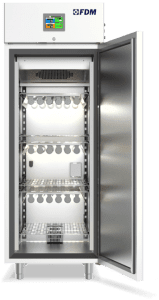
Incubators are laboratory instruments that play a crucial role in many sectors, from medicine to scientific research and breeding.
Controlling humidity in incubator is essential to ensure the effectiveness of the project we are following.
In this article we will deal with the importance of humidity in the laboratory incubator.
But first of all, let's see what an incubator is.
What is an Incubator?
An incubator is a laboratory instrument capable of simulating a suitable environment for the growth and development of organisms, microorganisms, cell cultures, plants and small insects.
It is an environment isolated from the outside in which it is possible to set, regulate and monitor a series of environmental parameters - including temperature, humidity and CO2 density - which allow the controlled growth of the sample we are going to place inside the incubator.
Laboratory incubators are therefore fundamental for all types of biological research, whether for medical, scientific or food purposes because they allow us to understand the optimal growth conditions of the sample and how to achieve them.
Importance of Humidity in Incubator
Humidity in incubator - together with temperature, CO2 and ventilation - is one of the four fundamental factors for creating a climate-controlled environment.
The relative humidity of an environment is an indicator of the quantity of vapor contained therein. Precise incubator humidity levels are essential for any type of culture because they directly affect biological processes. Furthermore, humidity in the incubator is not an independent variable but is closely linked to temperature and ventilation. For this reason, controlling the humidity in the incubator is a necessary task.
Illumination Chamber
Discover the latest features of FDM Growth Chambers.
Controlling Humidity in Incubator:
Here are three useful tips for controlling humidity in incubator effectively:
- Gradual Adjustment: Avoid sudden changes in incubation environments. Relative humidity is a delicate parameter and must be adjusted gradually to ensure a stress-free transition for growing organisms.
- Regular Measurement: constantly monitor the humidity levels inside the incubator and remember that relative humidity varies in relation to other parameters.
- Triangle with the other parameters: 50% relative humidity at 20° is not the same as 50% relative humidity at 80°. Always take into account all the parameters to evaluate the suitability of the environment you are creating.
You cannot find the ideal chamber for your test?
Create your own environment, according to any test requirement
Incubator or Climatic Chamber?
The laboratory incubator is a very useful tool for growing organisms in a controlled environment but it also has its limitations.
In fact, laboratory incubators fall into the broader class of climatic chambers but with a range of applications limited by the maximum values they can reach.
We have dedicated an entire article, this one, to explain the difference between an incubator and a climatic chamber and why the latter is preferable in all respects.
The FDM Growth Chamber
The FDM Growth Chamber is a professional incubator which, in addition to controlling temperature and relative humidity, adds different lighting sets capable of simulating various types of sunlight and creating environments suitable for each crop.
FDM can also modify growth chambers and climate chambers to implement CO2 control.
For further needs, please do not hesitate to contact us.
Would you like to receive a quote or do you have questions about the product?
Contact us to receive more information about this Product.



